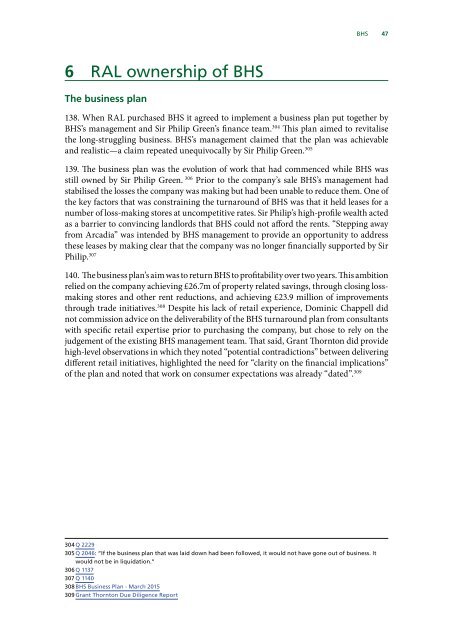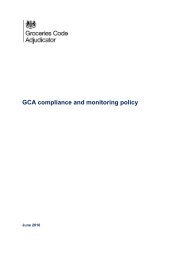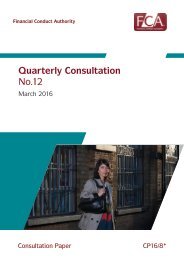Create successful ePaper yourself
Turn your PDF publications into a flip-book with our unique Google optimized e-Paper software.
<strong>BHS</strong><br />
47<br />
6 RAL ownership of <strong>BHS</strong><br />
The business plan<br />
138. When RAL purchased <strong>BHS</strong> it agreed to implement a business plan put together by<br />
<strong>BHS</strong>’s management and Sir Philip Green’s finance team. 304 This plan aimed to revitalise<br />
the long-struggling business. <strong>BHS</strong>’s management claimed that the plan was achievable<br />
and realistic—a claim repeated unequivocally by Sir Philip Green. 305<br />
139. The business plan was the evolution of work that had commenced while <strong>BHS</strong> was<br />
still owned by Sir Philip Green. 306 Prior to the company’s sale <strong>BHS</strong>’s management had<br />
stabilised the losses the company was making but had been unable to reduce them. One of<br />
the key factors that was constraining the turnaround of <strong>BHS</strong> was that it held leases for a<br />
number of loss-making stores at uncompetitive rates. Sir Philip’s high-profile wealth acted<br />
as a barrier to convincing landlords that <strong>BHS</strong> could not afford the rents. “Stepping away<br />
from Arcadia” was intended by <strong>BHS</strong> management to provide an opportunity to address<br />
these leases by making clear that the company was no longer financially supported by Sir<br />
Philip. 307<br />
140. The business plan’s aim was to return <strong>BHS</strong> to profitability over two years. This ambition<br />
relied on the company achieving £26.7m of property related savings, through closing lossmaking<br />
stores and other rent reductions, and achieving £23.9 million of improvements<br />
through trade initiatives. 308 Despite his lack of retail experience, Dominic Chappell did<br />
not commission advice on the deliverability of the <strong>BHS</strong> turnaround plan from consultants<br />
with specific retail expertise prior to purchasing the company, but chose to rely on the<br />
judgement of the existing <strong>BHS</strong> management team. That said, Grant Thornton did provide<br />
high-level observations in which they noted “potential contradictions” between delivering<br />
different retail initiatives, highlighted the need for “clarity on the financial implications”<br />
of the plan and noted that work on consumer expectations was already “dated”. 309<br />
304 Q 2229<br />
305 Q 2046: “If the business plan that was laid down had been followed, it would not have gone out of business. It<br />
would not be in liquidation.”<br />
306 Q 1137<br />
307 Q 1140<br />
308 <strong>BHS</strong> Business Plan - March 2015<br />
309 Grant Thornton Due Diligence Report






